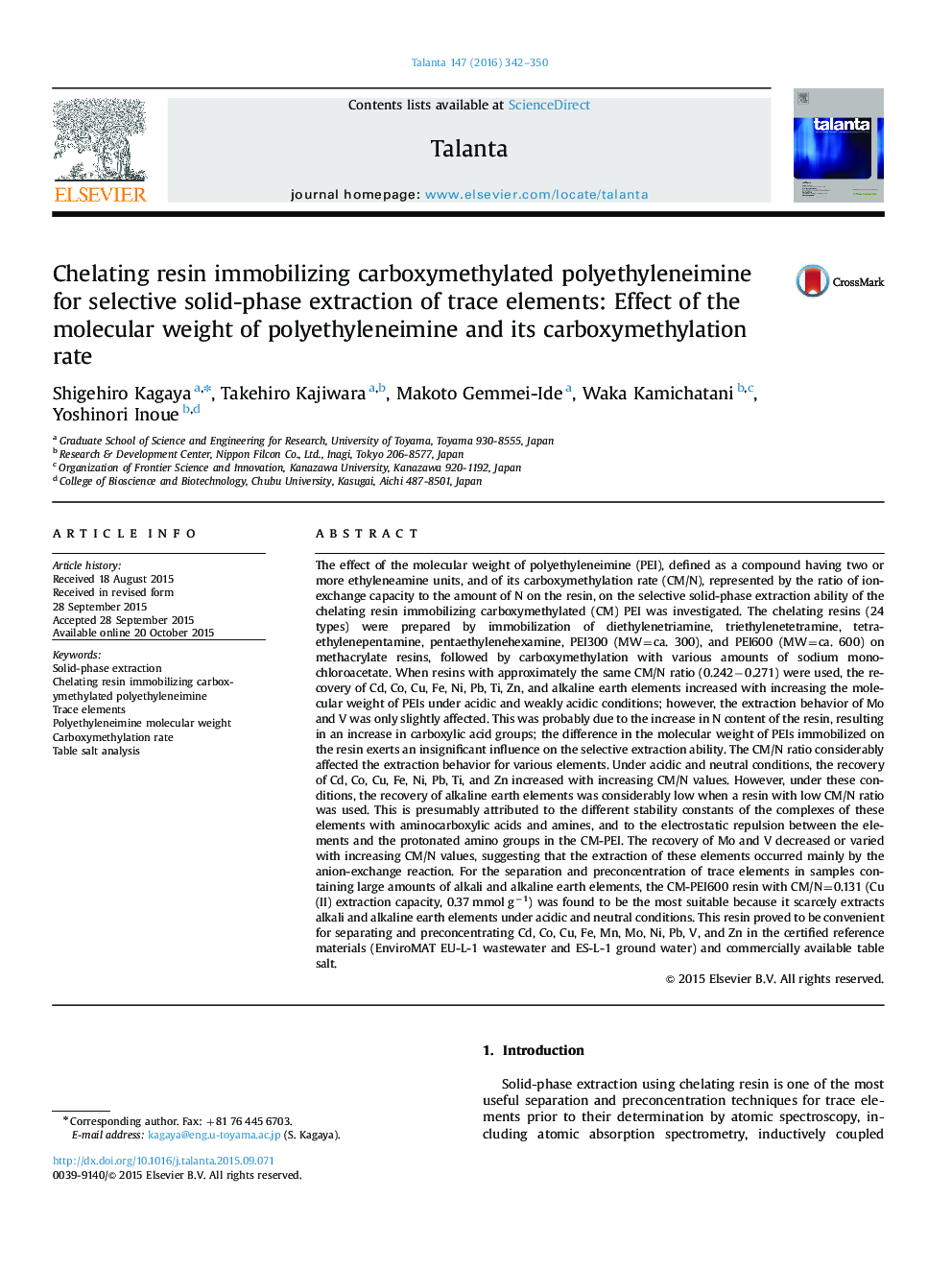| کد مقاله | کد نشریه | سال انتشار | مقاله انگلیسی | نسخه تمام متن |
|---|---|---|---|---|
| 1242765 | 1495788 | 2016 | 9 صفحه PDF | دانلود رایگان |
• Carboxymethylated polyethyeneimine (CM-PEI)-type chelating resins are prepared.
• The extraction capacity increases with increasing the molecular weight of PEI.
• The selectivity is controlled by the carboxymethylation (CM) rate.
• The resin at low CM rate scarcely extracts Ca even under neutral condition.
• The resin is useful for the separation and preconcentration of trace elements.
The effect of the molecular weight of polyethyleneimine (PEI), defined as a compound having two or more ethyleneamine units, and of its carboxymethylation rate (CM/N), represented by the ratio of ion-exchange capacity to the amount of N on the resin, on the selective solid-phase extraction ability of the chelating resin immobilizing carboxymethylated (CM) PEI was investigated. The chelating resins (24 types) were prepared by immobilization of diethylenetriamine, triethylenetetramine, tetraethylenepentamine, pentaethylenehexamine, PEI300 (MW=ca. 300), and PEI600 (MW=ca. 600) on methacrylate resins, followed by carboxymethylation with various amounts of sodium monochloroacetate. When resins with approximately the same CM/N ratio (0.242−0.271) were used, the recovery of Cd, Co, Cu, Fe, Ni, Pb, Ti, Zn, and alkaline earth elements increased with increasing the molecular weight of PEIs under acidic and weakly acidic conditions; however, the extraction behavior of Mo and V was only slightly affected. This was probably due to the increase in N content of the resin, resulting in an increase in carboxylic acid groups; the difference in the molecular weight of PEIs immobilized on the resin exerts an insignificant influence on the selective extraction ability. The CM/N ratio considerably affected the extraction behavior for various elements. Under acidic and neutral conditions, the recovery of Cd, Co, Cu, Fe, Ni, Pb, Ti, and Zn increased with increasing CM/N values. However, under these conditions, the recovery of alkaline earth elements was considerably low when a resin with low CM/N ratio was used. This is presumably attributed to the different stability constants of the complexes of these elements with aminocarboxylic acids and amines, and to the electrostatic repulsion between the elements and the protonated amino groups in the CM-PEI. The recovery of Mo and V decreased or varied with increasing CM/N values, suggesting that the extraction of these elements occurred mainly by the anion-exchange reaction. For the separation and preconcentration of trace elements in samples containing large amounts of alkali and alkaline earth elements, the CM-PEI600 resin with CM/N=0.131 (Cu(II) extraction capacity, 0.37 mmol g−1) was found to be the most suitable because it scarcely extracts alkali and alkaline earth elements under acidic and neutral conditions. This resin proved to be convenient for separating and preconcentrating Cd, Co, Cu, Fe, Mn, Mo, Ni, Pb, V, and Zn in the certified reference materials (EnviroMAT EU-L-1 wastewater and ES-L-1 ground water) and commercially available table salt.
Figure optionsDownload as PowerPoint slide
Journal: Talanta - Volume 147, 15 January 2016, Pages 342–350
